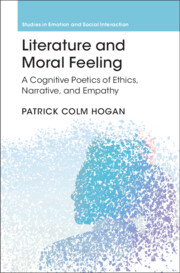Book contents
- Literature and Moral Feeling
- Studies in Emotion and Social Interaction
- Literature and Moral Feeling
- Copyright page
- Dedication
- Contents
- Figures
- Acknowledgments
- Introduction:
- Chapter 1 Defining Ethics
- Chapter 2 The Implied Ethics of Julius Caesar
- Chapter 3 Narrative Universals, Emotion, and Ethics
- Chapter 4 Ethics and Narrative Genre:
- Chapter 5 Emotion and Empathy
- Chapter 6 The Dynamics of Empathic Response:
- Chapter 7 Evaluating Empathy
- Chapter 8 The Critical Empathy of Angels in America
- Afterword:
- References
- Index
- Studies in Emotion and Social Interaction
Chapter 4 - Ethics and Narrative Genre:
Some Illustrative Cases
Published online by Cambridge University Press: 21 April 2022
- Literature and Moral Feeling
- Studies in Emotion and Social Interaction
- Literature and Moral Feeling
- Copyright page
- Dedication
- Contents
- Figures
- Acknowledgments
- Introduction:
- Chapter 1 Defining Ethics
- Chapter 2 The Implied Ethics of Julius Caesar
- Chapter 3 Narrative Universals, Emotion, and Ethics
- Chapter 4 Ethics and Narrative Genre:
- Chapter 5 Emotion and Empathy
- Chapter 6 The Dynamics of Empathic Response:
- Chapter 7 Evaluating Empathy
- Chapter 8 The Critical Empathy of Angels in America
- Afterword:
- References
- Index
- Studies in Emotion and Social Interaction
Summary
Just as the second chapter provides a literary development of the relatively abstract first chapter, so too the fourth chapter provides literary developments of the cross-cultural genres treated in the third chapter. Specifically, this chapter considers literary cases of all the prominent, universal genres, examining their implications for ethical evaluation and action. In keeping with the cross-cultural range of these genres, this chapter considers works from different time periods and different regions. It includes discussions of the Bhagavad Gītā, Hamlet, and All’s Well That Ends Well, Yuan period Chinese dramas (The Zhao Orphan and Selling Rice in Chenzhou), as well as more recent fiction and nonfiction from India (Nectar in a Sieve) and Australia (Follow the Rabbit-Proof Fence). The longest section develops a particularly detailed interpretation of the sacrificial structure in F. W. Murnau’s film, Nosferatu. I undertake a more extensive development of this analysis to illustrate more clearly the impact of story structure on moral response.
Keywords
- Type
- Chapter
- Information
- Literature and Moral FeelingA Cognitive Poetics of Ethics, Narrative, and Empathy, pp. 89 - 149Publisher: Cambridge University PressPrint publication year: 2022

